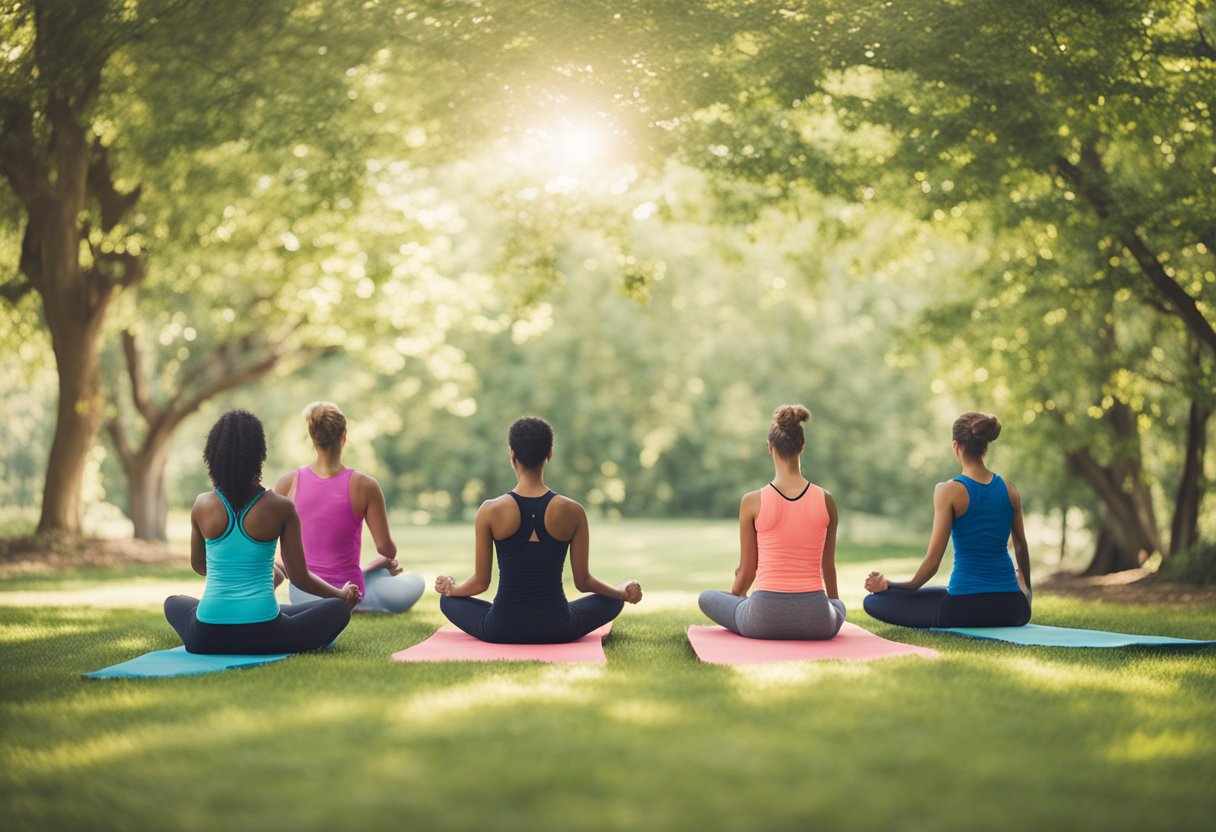Essential Tips and Strategies
Surviving cancer is no small feat, and staying healthy afterward requires a well-thought-out routine.
Regular physical activity supports both body and mind. Exercise helped us regain strength and kept us positive when times were tough.

Moving daily is vital, whether a brisk walk or light resistance training.
Fitness routines for cancer thrivers should be personalized.
Starting slowly and increasing activity helps avoid burnout.
Simple activities like house cleaning or short walks can make a big difference.
We can build up to more vigorous exercises as our strength returns.
Adopting a healthy lifestyle is essential.
Small changes, such as better nutrition and consistent exercise, can significantly enhance our quality of life.
The goal is to stay active, eat well, and surround ourselves with supportive communities.
Key Takeaways
- Regular exercise aids both physical and mental health.
- Personalized fitness routines are crucial for cancer survivors.
- A healthy lifestyle enhances the post-cancer quality of life.
Understanding Cancer and Physical Wellness

Regular physical activity supports body and mind, helping cancer survivors maintain their health and vitality.
We’ll explore how exercise can prevent cancer and discuss different types of cancer and their specific exercise needs.
The Role of Physical Activity in Cancer Prevention
Physical activity plays a crucial role in reducing the risk of developing cancer.
Regular exercise helps us manage our weight, which is a significant factor in cancer prevention.
By maintaining a healthy weight, we reduce the risk of various cancers, such as colon and prostate cancer.
Exercise also boosts our immune system. This enhancement allows our body to fight off potential cancer cells more effectively.
Physical activity also helps regulate hormones and reduce inflammation, contributing to a lower cancer risk.
We should aim for at least 150 minutes of moderate-intensity or 75 minutes of vigorous exercise each week.
This can include activities like brisk walking, cycling, or swimming.
Consistency is crucial, and spreading the activity throughout the week is beneficial.
Types of Cancer: Implications for Exercise
Different types of cancer can affect how we exercise.
For those of us who have faced cancers like lymphoma or prostate cancer, specific exercises may be more suitable.
Consulting with healthcare professionals before starting any new routine is essential.
Low-impact activities such as walking, yoga, and swimming are recommended for lymphoma survivors. These exercises help maintain strength and improve overall well-being without putting too much strain on the body.
Men with prostate cancer should focus on gentle strength training and stretching.
Resistance exercises help counter muscle loss that can occur during treatment. Flexibility exercises like stretching or yoga can also improve mobility and reduce side effects.
In all cases, the goal is to find enjoyable and sustainable activities.
Listening to our bodies and progressing comfortably ensures we stay active without overdoing it.
Regularly incorporating these exercises can significantly enhance our quality of life and support our ongoing health journey.
Developing a Personalized Exercise Program
Creating a personalized exercise program tailored to our needs as cancer survivors is essential.
It involves thorough assessment, setting achievable goals, and including diverse exercise types to enhance overall wellness.
Assessment with Health Care Team
First, we need to schedule an appointment with our healthcare team.
They will evaluate our current physical condition and medical history.
This includes checking for any limitations or concerns stemming from past treatments.
Discussing our energy levels, lingering side effects and specific body areas that need more robust support helps craft a precise plan.
The American College of Sports Medicine guidance may come into play here.
Their expertise will ensure safety and effectiveness so we avoid injuries while achieving the best outcomes.
Setting Realistic Goals
We must set realistic goals once we better understand our current physical status.
We should begin with small, achievable milestones and gradually increase the intensity.
For example, if we have been inactive, starting with short walks or gentle stretching can build a foundation.
Over time, we can increase the duration and intensity of our activities.
The idea is to aim for progress, not perfection.
Keeping track of our achievements, no matter how minor contributes significantly to long-term success and boosts our confidence and motivation.
Incorporating Various Types of Exercises
Our exercise plan should include multiple types of physical activities to benefit different parts of our bodies.
Aerobic exercises like walking, swimming, or cycling improve cardiovascular health and endurance.
Targeting around 150-300 minutes per week helps maintain a healthy heart.
Resistance training, done at least twice a week, is vital for building strength.
Activities like weight lifting or using resistance bands can help us regain muscle mass that might have been lost during treatment.
Stretching exercises keep our muscles flexible, reducing the risk of injury and enhancing movement.
By incorporating various exercise types and consistently following our personalized program, we can support both body and mind, ensuring a healthier survival journey.
Essential Lifestyle Changes for Cancer Survivors
A balanced diet, restful sleep, and mental health are crucial for cancer survivors to sustain their well-being and vitality. Our experiences highlight the need to address these areas effectively.
Nutritional Adjustments for Enhanced Energy
Eating a nutritious diet helps in managing fatigue and maintaining energy levels.
We should focus on consuming whole foods, like vegetables, fruits, lean proteins, and whole grains.
These foods provide essential vitamins and minerals necessary for recovery.
Avoiding processed foods and sugary drinks is beneficial.
More importantly, staying hydrated supports bodily functions and prevents fatigue.
Eating smaller, frequent meals can help manage nausea and maintain consistent energy levels.
Including foods rich in antioxidants, like berries and nuts, helps fight free radicals.
Additionally, incorporating omega-3 fatty acids from fish or flaxseeds supports heart health and reduces inflammation.
Sleep Quality and Its Impact on Wellness
Quality sleep plays a vital role in our recovery and overall health.
Creating a sleep routine helps achieve more profound, restful sleep.
We should aim for 7-9 hours each night to allow our bodies to repair and rejuvenate.
Avoiding caffeine and electronics before bed can improve sleep quality.
Relaxation techniques such as deep breathing or yoga can reduce stress and anxiety, making it easier to fall asleep.
Maintaining a comfortable sleep environment by keeping the room dark and cool also aids in better sleep.
If sleep disturbances persist, consulting a healthcare provider can uncover underlying issues and provide tailored solutions.
The Importance of Mental Wellbeing
Mental well-being is as crucial as physical health.
Dealing with cancer and its aftermath often leads to anxiety, depression, and lowered self-esteem.
Mindfulness practices, such as meditation or journaling, help manage these emotions.
Building a support system of friends, family, or support groups can provide emotional strength and reduce feelings of isolation.
Participating in enjoyable activities or hobbies keeps our minds engaged and spirits lifted.
Focusing on spiritual health through prayer or connecting with nature offers peace and purpose.
Seeking professional counseling when needed ensures we have the tools to cope with ongoing challenges.
Exercise Benefits and Managing Side Effects

Regular physical activity supports both the body and mind. Here is how we can maintain health and vitality through specific exercise routines.
Boosting Muscle and Bone Strength
Engaging in physical exercise helps us strengthen our muscles and maintain bone density.
Weight-bearing activities like walking, jogging, or resistance training increase our skeletal system’s physical function and strength.
These exercises also enhance our muscle composition, supporting overall body balance and posture.
Men diagnosed with cancer often face muscle loss.
We can prevent muscle weakness and sustain our bone health by using strength training exercises such as lifting weights or resistance bands.
Consistent strength training can also reduce the risk of osteoporosis, a common concern for many cancer survivors.
Exercise to Alleviate Treatment Side Effects
Chemotherapy and radiation can leave us feeling fatigued and affect our energy levels.
Physical activity can significantly alleviate side effects such as fatigue, cancer cachexia, and cognitive impairments.
Gentle activities like walking, swimming, or yoga can help manage lymphedema and reduce pain or muscle stiffness, enhancing our comfort during recovery.
We must listen to our bodies and start with lower-intensity exercises, gradually increasing the intensity.
This way, we can build our endurance without overexertion.
Regular activity helps boost our mental well-being and provides a better quality of life during and after treatment.
For details, refer to how exercise can lower cancer risk.
Community Support: Finding and Sharing Resources

Connecting with others in similar situations can significantly aid in maintaining physical wellness and finding necessary resources. Our combined efforts make this journey more manageable.
Leveraging Communities for Motivation
Joining support groups provides emotional uplift and practical advice. Whether online or in-person, these groups offer a space for sharing experiences and tips. We often find motivation by seeing how others handle their challenges. Social media platforms host various groups where we can connect with fellow survivors.
Participating in local community events can also boost morale. Events organized by the American Cancer Society or National Cancer Institute provide opportunities to learn new wellness strategies. These events often feature talks from professionals and survivors, fostering a sense of camaraderie.
Personal stories shared in these communities remind us that we are not alone. They inspire us to keep pushing forward, even on tough days. This shared journey helps us build resilience and stay committed to our wellness routines.
Accessing Professional Resources and Education
Accessing professional resources ensures we receive accurate and up-to-date information. Websites like the National Cancer Institute offer a wealth of information on physical wellness practices. These institutions provide guidelines on fitness routines, nutrition, and other wellness tips tailored to men living with cancer.
Speaking with healthcare providers is crucial. They can recommend specific programs or physical activities that suit our needs. Cancer care centers often have specialists, like nutritionists and fitness trainers, who can personalize our wellness plans.
Many organizations offer educational workshops and webinars. For instance, the American Cancer Society organizes various events, from managing side effects to maintaining daily exercise. Educating ourselves empowers us to make better decisions about our health and wellness.
Integrating Exercise into Daily Routine

Regular physical activity supports both body and mind. To help maintain health and vitality, we can incorporate fitness routines and wellness tips into everyday activities.
Balancing Work and Exercise
Balancing work and exercise can be challenging, especially for cancer survivors. Finding small pockets of time throughout the day aids in maintaining a regular exercise routine. For instance, a 10-minute walk during lunch breaks or standing while working can add beneficial movement without disrupting our work schedule.
Integrate walking meetings for discussions and opt for stairs instead of elevators. These small changes promote consistent activity. Visiting the gym before or after work can also be effective for those who can. Using desk stretch bands or light weights can enhance strength without leaving the workspace.
Fun Ways to Stay Active
Staying active doesn’t have to be tedious. Engaging in fun activities keeps us motivated. Activities like yoga classes or group sports can be both enjoyable and social. Incorporating hobbies like cycling, dancing, or even playing a game of basketball with friends can inject excitement into our routine.
Opt for exercises that bring joy, like swimming or playing soccer. Fun physical activities improve both our body and mind, which is especially valuable after surviving cancer. Mixing up different types of exercise prevents boredom and keeps our routine vibrant.
Continuity and Regular Exercise Commitment
A commitment to regular exercise is essential for long-term well-being. Setting a weekly fitness goal can help us stay on track. For instance, aiming for 150 to 300 minutes of moderate exercise each week ensures a balanced routine. Activities can range from brisk walking to resistance training.
Creating a schedule that includes specific workout times helps in maintaining consistency. Group exercises, like attending a weekly yoga class, provide structure. Leveraging exercise resources, such as online classes or fitness apps, can offer guidance and motivation. Regular commitment ensures we stay healthy and robust, fostering an active lifestyle.
Monitoring Progress and Preventing Recurrence

Regular physical activity supports both body and mind. We outline how fitness routines and wellness tips can help cancer survivors maintain their health and vitality.
Tracking Physical Activity and Health Metrics
Monitoring our physical activity and various health metrics is crucial to keep tabs on our health. By tracking these indicators, we can make informed decisions about our routines and adjustments needed.
Monitoring muscle mass, heart rate, and sleep patterns provides a comprehensive picture of our overall health. Devices like fitness trackers and smartwatches help us stay accountable. We should also regularly measure our weight, body fat percentage, and daily steps.
In addition, maintaining a log of workouts or using apps to record exercise sessions helps set realistic goals. Keeping track of our diet and hydration supports our wellness journey.
Insights into Cancer Recurrence and Health Maintenance
Preventing cancer recurrence requires continuous observation and following a tailored fitness plan. Studies show that consistent exercise can significantly decrease the risk of recurrence for various cancers, including lymphoma.
It’s beneficial to have regular medical check-ups to monitor any signs of cancer recurrence. Health maintenance involves integrating activities like cardio workouts and strength training to boost overall quality of life.
A balanced routine not only aids in survival but also helps prevent associated diseases like heart disease and stroke. Engaging in hobbies or sports, we love can make exercise enjoyable and sustainable, ensuring we continue to thrive and stay motivated in our wellness journey.
Final Thoughts
As survivors, we know that staying active is vital in our journey. Regular physical activity helps us maintain strength and mental clarity.
Tips for Physical Wellness
- Start Slow: Begin with walking or light jogging. Gradually increase intensity.
- Consistency Matters: Aim for at least 150 minutes of moderate weekly activity.
- Strength Training: Incorporate resistance exercises two times a week.
Sample Weekly Routine
| Day | Activity |
|---|---|
| Monday | 30 min walk, stretching |
| Tuesday | 20 min resistance training |
| Wednesday | 30 min cycling |
| Thursday | 20 min resistance training |
| Friday | 30 min walk, stretching |
| Saturday | 30 min hiking or jogging |
| Sunday | Rest or light yoga |
Sports like tennis or basketball can also keep us active and social. Exercising outdoors can elevate our mood. -T
Frequently Asked Questions
Regular physical activity supports both body and mind. Let’s outline fitness routines and wellness tips that help cancer survivors maintain their health and vitality.
What forms of physical exercise are recommended for individuals undergoing cancer treatment?
We should focus on moderate activities like walking or cycling. Aiming for 150-300 minutes of moderate activity per week is helpful. This sort of exercise can easily be adapted to our comfort levels, making it easier to maintain a routine.
How can strength training safely be incorporated into a cancer patient’s wellness routine?
To incorporate strength training safely, we can start with very light weights or resistance bands. Training twice a week is a good frequency. It’s crucial to avoid overexertion and listen to our bodies. Check with our healthcare team to design a routine that fits our health status.
Are there specific physical activities that have been shown to improve longevity in cancer thrivers?
Regular aerobic exercises such as swimming or brisk walking can significantly benefit us. Studies show that these activities can effectively reduce the risk of cancer recurrence. Engaging in these activities consistently helps us improve our overall well-being.
What precautions should be taken when cancer patients engage in exercise regimens?
We must ensure we stay hydrated and wear proper footwear to prevent injuries. It’s also advisable to avoid outdoor activities during extreme weather. Always warm up before any exercise and cool down afterward. Monitoring our physical responses and adjusting activity levels are essential for our safety.
In what ways can exercise potentially affect the progression or spread of cancer?
Exercise can positively impact our immune system, which may help manage cancer. Regular physical activities can also help improve our energy levels and reduce fatigue. Keeping an active lifestyle promotes better overall health, potentially influencing cancer outcomes.
How can a cancer thriver effectively balance wellness activities with their treatment schedule?
We should plan short sessions of physical activity around treatment times. Engaging in gentle exercises like stretching or yoga on rest days is feasible.
Balancing activity with adequate rest ensures we don’t overburden our bodies while maintaining our fitness. Regular consultations with our healthcare team are crucial in adopting this balance.
